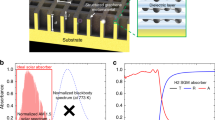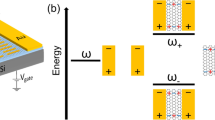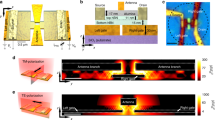Abstract
Broadband strong light absorption of unpolarized light over a wide range of angles in a large-area ultrathin film is critical for applications such as photovoltaics, photodetectors, thermal emitters and optical modulators. Despite long-standing efforts in design and fabrication, it has been challenging to achieve all these desired properties simultaneously. We experimentally demonstrate a 12.5 cm2, 90-nm-thick graphene metamaterial with approximately 85% absorptivity of unpolarized, visible and near-infrared light covering almost the entire solar spectrum (300–2,500 nm). The metamaterial consists of alternating graphene and dielectric layers; a grating couples the light into waveguide modes to achieve broadband absorption over incident angles up to 60°. The very broad spectral and angular responses of the absorber are ideal for solar thermal applications, as we illustrate by showing heating to 160 °C in natural sunlight. These devices open a novel approach to applications of strongly absorbing large-area photonic devices based on two-dimensional materials.
This is a preview of subscription content, access via your institution
Access options
Access Nature and 54 other Nature Portfolio journals
Get Nature+, our best-value online-access subscription
$29.99 / 30 days
cancel any time
Subscribe to this journal
Receive 12 print issues and online access
$209.00 per year
only $17.42 per issue
Buy this article
- Purchase on Springer Link
- Instant access to full article PDF
Prices may be subject to local taxes which are calculated during checkout





Similar content being viewed by others
Data availability
The data that support the plots within this paper and other findings of this study are available from the corresponding authors upon reasonable request.
References
Cao, A., Zhang, X., Xu, C., Wei, B. & Wu, D. Tandem structure of aligned carbon nanotubes on Au and its solar thermal absorption. Sol. Energy Mater. Sol. Cells 70, 481–486 (2002).
Ghasemi, H. et al. Solar steam generation by heat localization. Nat. Commun. 5, 4449 (2014).
Ren, H. et al. Hierarchical graphene foam for efficient omnidirectional solar–thermal energy conversion. Adv. Mater. 29, 1702590 (2017).
Zhu, M. et al. Tree‐inspired design for high‐efficiency water extraction. Adv. Mater. 29, 1704107 (2017).
Li, X. et al. Graphene oxide-based efficient and scalable solar desalination under one sun with a confined 2D water path. Proc. Natl Acad. Sci. USA 113, 13953–13958 (2016).
Huang, J. et al. Harnessing structural darkness in the visible and infrared wavelengths for a new source of light. Nat. Nanotechnol. 11, 60–66 (2015).
Yao, Y. et al. Electrically tunable metasurface perfect absorbers for ultrathin mid-infrared optical modulators. Nano Lett. 14, 6526–6532 (2014).
Li, W. & Valentine, J. Metamaterial perfect absorber based hot electron photodetection. Nano Lett. 14, 3510–3514 (2014).
Mellouki, I., Bennaji, N. & Yacoubi, N. IR characterization of graphite black-coating for cryogenic detectors. Infrared Phys. Technol. 50, 58–62 (2007).
Shi, H., Ok, J. G., Won Baac, H. & Jay Guo, L. Low density carbon nanotube forest as an index-matched and near perfect absorption coating. Appl. Phys. Lett. 99, 211103 (2011).
Mizuno, K. et al. A black body absorber from vertically aligned single-walled carbon nanotubes. Proc. Natl Acad. Sci. USA 106, 6044–6047 (2009).
Xu, T. et al. Structural colors: from plasmonic to carbon nanostructures. Small 7, 3128–3136 (2011).
Hedayati, M. K., Faupel, F. & Elbahri, M. Tunable broadband plasmonic perfect absorber at visible frequency. Appl. Phys. A 109, 769–773 (2012).
Zhou, L. et al. 3D self-assembly of aluminium nanoparticles for plasmon-enhanced solar desalination. Nat. Photon. 10, 393–398 (2016).
Zhou, L. et al. Self-assembled spectrum selective plasmonic absorbers with tunable bandwidth for solar energy conversion. Nano Energy 32, 195–200 (2017).
Hedayati, M. K. et al. Design of a perfect black absorber at visible frequencies using plasmonic metamaterials. Adv. Mater. 23, 5410–5414 (2011).
Aydin, K., Ferry, V. E., Briggs, R. M. & Atwater, H. A. Broadband polarization-independent resonant light absorption using ultrathin plasmonic super absorbers. Nat. Commun. 2, 517 (2011).
Landy, N., Sajuyigbe, S., Mock, J., Smith, D. & Padilla, W. Perfect metamaterial absorber. Phys. Rev. Lett. 100, 207402 (2008).
Massiot, I. et al. Metal nanogrid for broadband multiresonant light-harvesting in ultrathin GaAs layers. ACS Photonics 1, 878–884 (2014).
Ding, F. et al. Ultrabroadband strong light absorption based on thin multilayered metamaterials. Laser Photonics Rev. 8, 946–953 (2014).
Wu, D. et al. Numerical study of the wide‐angle polarization‐independent ultra‐broadband efficient selective solar absorber in the entire solar spectrum. Solar RRL 1, 1770126 (2017).
Sturmberg, B. C. et al. Total absorption of visible light in ultrathin weakly absorbing semiconductor gratings. Optica 3, 556–562 (2016).
Zhu, L. et al. Angle-selective perfect absorption with two-dimensional materials. Light Sci. Appl. 5, e16052 (2016).
Xiang, Y. et al. Critical coupling with graphene-based hyperbolic metamaterials. Sci. Rep. 4, 5483 (2014).
Riley, C. T. et al. Near-perfect broadband absorption from hyperbolic metamaterial nanoparticles. Proc. Natl Acad. Sci. USA 114, 1264–1268 (2017).
Luo, H., Cheng, Y. & Gong, R. Numerical study of metamaterial absorber and extending absorbance bandwidth based on multi-square patches. Eur. Phys. J. B 81, 387–392 (2011).
Popov, E. et al. Total absorption of unpolarized light by crossed gratings. Opt. Express 16, 6146–6155 (2008).
Lee, K.-T., Ji, C. & Guo, L. J. Wide-angle, polarization-independent ultrathin broadband visible absorbers. Appl. Phys. Lett. 108, 031107 (2016).
Lin, S.-Y., Moreno, J. & Fleming, J. Three-dimensional photonic-crystal emitter for thermal photovoltaic power generation. Appl. Phys. Lett. 83, 380–382 (2003).
Li, Z., Palacios, E., Butun, S., Kocer, H. & Aydin, K. Omnidirectional, broadband light absorption using large-area, ultrathin lossy metallic film coatings. Sci. Rep. 5, 15137 (2015).
Koppens, F. et al. Photodetectors based on graphene, other two-dimensional materials and hybrid systems. Nat. Nanotechnol. 9, 780–793 (2014).
Nair, R. R. et al. Fine structure constant defines visual transparency of graphene. Science 320, 1308–1308 (2008).
Ferreira, A. & Peres, N. Complete light absorption in graphene-metamaterial corrugated structures. Phys. Rev. B 86, 205401 (2012).
Thongrattanasiri, S., Koppens, F. H. & de Abajo, F. J. G. Complete optical absorption in periodically patterned graphene. Phys. Rev. Lett. 108, 047401 (2012).
Ferreira, A., Peres, N., Ribeiro, R. & Stauber, T. Graphene-based photodetector with two cavities. Phys. Rev. B 85, 115438 (2012).
Nefedov, I. S., Valaginnopoulos, C. A. & Melnikov, L. A. Perfect absorption in graphene multilayers. J. Opt. 15, 114003 (2013).
Chang, Y.-C. et al. Realization of mid-infrared graphene hyperbolic metamaterials. Nat. Commun. 7, 10568 (2016).
Zheng, X. et al. Highly efficient and ultra-broadband graphene oxide ultrathin lenses with three-dimensional subwavelength focusing. Nat. Commun. 6, 8433 (2015).
Kaltenbrunner, M. et al. Ultrathin and lightweight organic solar cells with high flexibility. Nat. Commun. 3, 770 (2012).
Fang, A., Koschny, T. & Soukoulis, C. M. Optical anisotropic metamaterials: Negative refraction and focusing. Phys. Rev. B 79, 245127 (2009).
Dossou, K. B. et al. Modal formulation for diffraction by absorbing photonic crystal slabs. JOSA A 29, 817–831 (2012).
Sturmberg, B. C. et al. EMUstack: an open source route to insightful electromagnetic computation via the Bloch mode scattering matrix method. Comput. Phys. Commun. 202, 276–286 (2016).
Kotov, N. A., Dékány, I. & Fendler, J. H. Ultrathin graphite oxide–polyelectrolyte composites prepared by self‐assembly: Transition between conductive and non‐conductive states. Adv. Mater. 8, 637–641 (1996).
Zhang, Y. L. et al. Photoreduction of graphene oxides: methods, properties, and applications. Adv. Opt. Mater. 2, 10–28 (2014).
Zheng, X., Jia, B., Chen, X. & Gu, M. In situ third‐order non‐linear responses during laser reduction of graphene oxide thin films towards on‐chip non‐linear photonic devices. Adv. Mater. 26, 2699–2703 (2014).
Guo, L. et al. Laser‐mediated programmable N doping and simultaneous reduction of graphene oxides. Adv. Opt. Mater. 2, 120–125 (2014).
Kravets, V. et al. Spectroscopic ellipsometry of graphene and an exciton-shifted van Hove peak in absorption. Phys. Rev. B 81, 155413 (2010).
Bouchitté, G. & Petit, R. On the concepts of a perfectly conducting material and of a perfectly conducting and infinitely thin screen. Radio Sci. 24, 13–26 (1989).
Booth, H. Laser processing in industrial solar module manufacturing. J. Laser Micro. Nanoen. 5, 183–191 (2010).
Hummers, W. S. Jr & Offeman, R. E. Preparation of graphitic oxide. J. Am. Chem. Soc. 80, 1339–1339 (1958).
Acknowledgements
B.J. and K.L. acknowledge the support from the Australian Research Council (DP190103186). Discussions with K. Catchpole and T. White from the Australian National University during the early stages of this research are gratefully acknowledged.
Author information
Authors and Affiliations
Contributions
H.L., B.S., C.M.d.S. and B.J. conceived original idea and proposed the project. H.L. X.Z. and Y.Y. carried out experiments including GO film synthesis, laser fabrication and characterizations. B.S. and C.M.d.S. developed the theoretical models and numerical simulations. T.C. coated the Ag reflector and SiO2 spacer layer on silicon substrates. H.L. and K.L. performed the thermal imaging and temperature measurement. H.L., K.L., B.S., C.M.d.S. and B.J. contributed to data analysis and writing and revising the manuscript. C.M.d.S. and B.J. supervised the project. All authors discussed the results and commented on the manuscript.
Corresponding authors
Ethics declarations
Competing interests
The authors declare no competing interests.
Additional information
Publisher’s note: Springer Nature remains neutral with regard to jurisdictional claims in published maps and institutional affiliations.
Supplementary information
Supplementary Information
Supplementary results and discussion, Supplementary Figures 1–17, Supplementary Tables 1–4 and Supplementary References 1–5.
Rights and permissions
About this article
Cite this article
Lin, H., Sturmberg, B.C.P., Lin, KT. et al. A 90-nm-thick graphene metamaterial for strong and extremely broadband absorption of unpolarized light. Nat. Photonics 13, 270–276 (2019). https://doi.org/10.1038/s41566-019-0389-3
Received:
Accepted:
Published:
Issue Date:
DOI: https://doi.org/10.1038/s41566-019-0389-3
This article is cited by
-
Synergistic-potential engineering enables high-efficiency graphene photodetectors for near- to mid-infrared light
Nature Communications (2024)
-
Perfect absorber based on symmetric square silicon grating with polarization and angular stability using particle swarm optimization algorithm
Optical and Quantum Electronics (2024)
-
Designing a Broadband Terahertz Metamaterial Absorber Through Bi-Layer Hybridization of Metal and Graphene
Plasmonics (2024)
-
Numerical investigation of MXene-based ultrawideband solar absorber with behaviour prediction using machine learning
Optical and Quantum Electronics (2024)
-
Fabrication of patterned transparent conductive glass via laser metal transfer for efficient electrical heating and antibacteria
Nano Research (2024)



